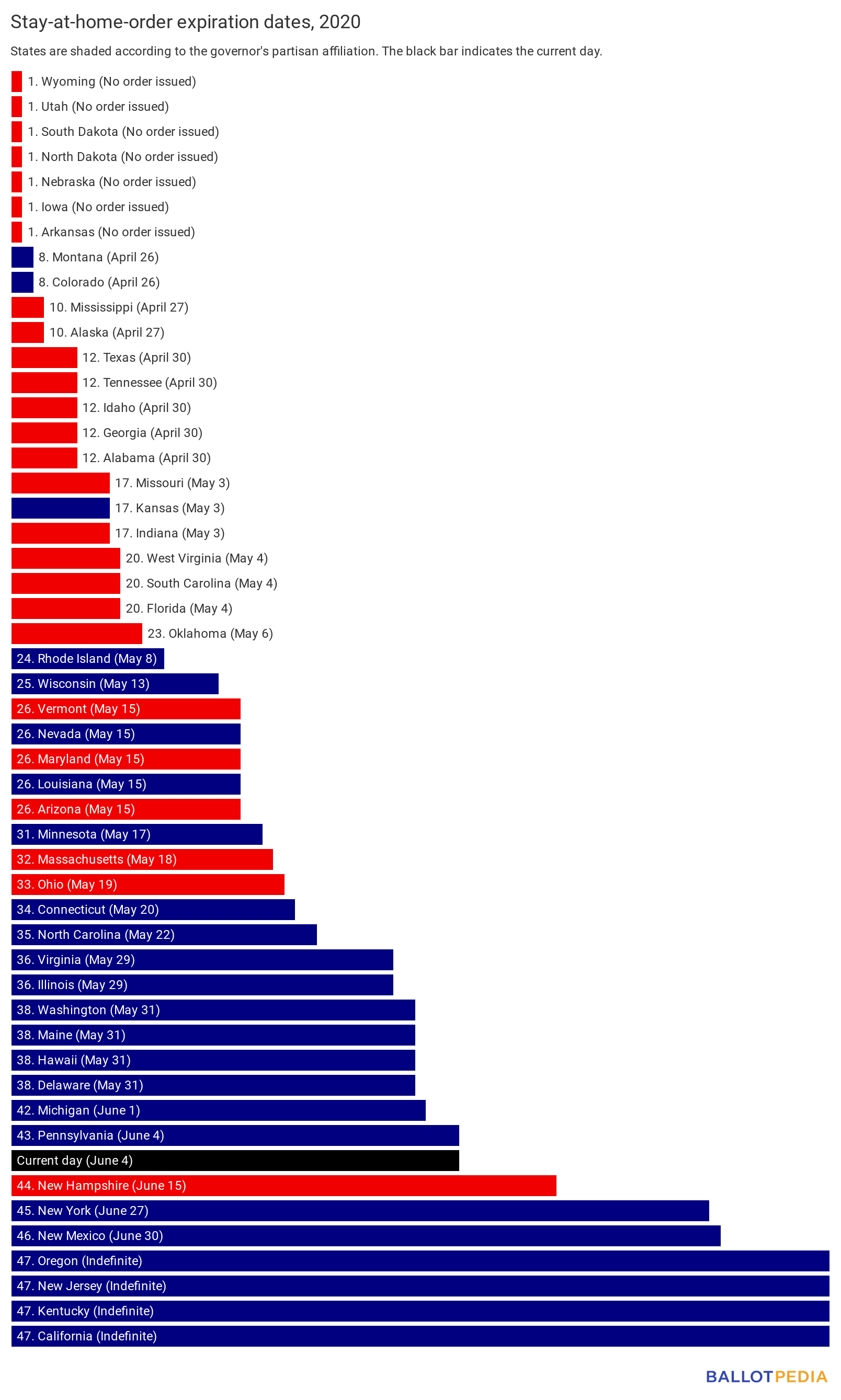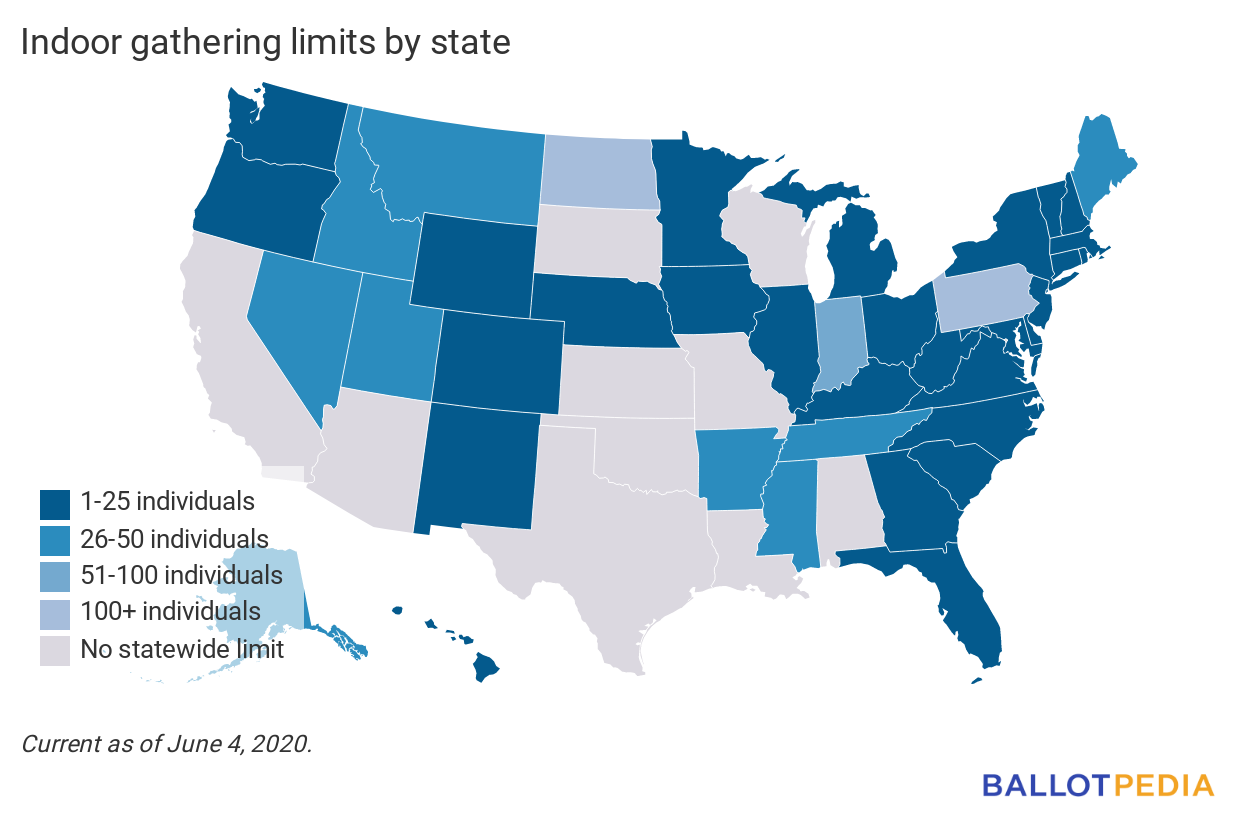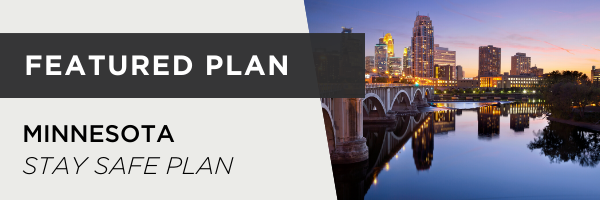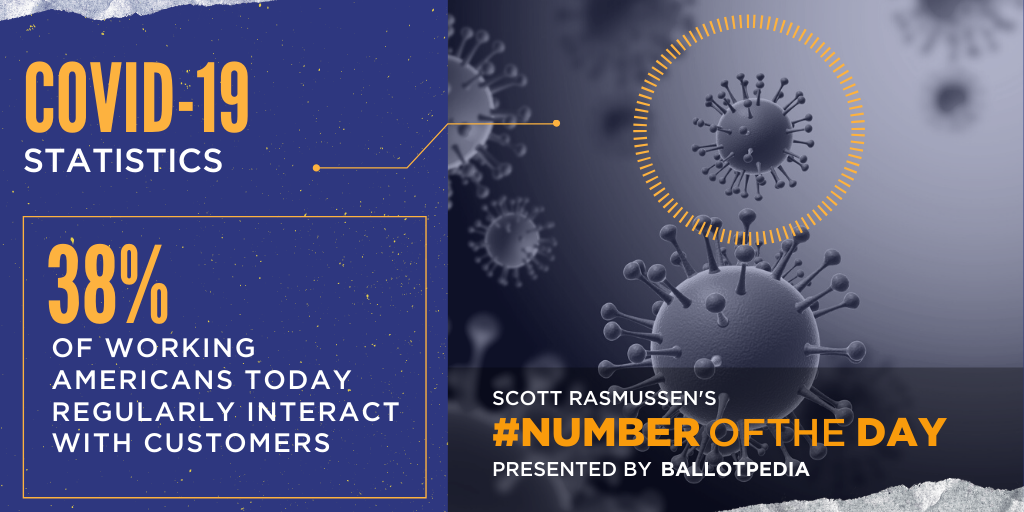Each day, we:
- Track the status of reopening in all 50 states.
- Compare the status of one industry or activity across the country.
- Provide in-depth summaries of the latest reopening plans.
- Give you the latest stories on other reopening plans and ideas.
Want to know what happened yesterday? Click here.
The next two days
What is reopening in the next two days? Which stay-at-home orders will expire?
June 5
- Louisiana (divided government): Louisiana will move into Phase 2 of its reopening plan on June 5. In Phase 2, the following businesses will be allowed to reopen at 50% capacity: restaurants and coffee shops; shopping malls; gyms and fitness centers; barbershops and nail salons; movie theaters; racetracks (without spectators); museums, zoos, and aquariums; bars and breweries with food permits; massage services; spas; tattoo parlors; esthetician services; pool halls, bowling alleys, and skating rinks; event centers and wedding venues; and outdoor playgrounds and play centers. Phase 2 will last at least 21 days.
- Maryland (divided government): Maryland will move into Stage 2 of its reopening at 5 p.m. on June 5. The order requiring the closure of non-essential businesses will be lifted, meaning most businesses that were not reopened under Stage 1 will be allowed to resume operations. Additional personal service businesses, including nail salons, massage parlors, tanning salons, and tattoo parlors, will be allowed to resume operations at 50% capacity, by appointment only. State government offices will also resume operations. The following businesses will remain closed: indoor entertainment facilities (e.g., bingo halls, bowling alleys); theaters; malls; fitness centers; and senior citizen activities.
- Vermont (divided government): Gov. Phil Scott (R) announced at a press conference on June 3 that he hopes to reopen restaurants to indoor dining on June 5. He also said he was working on a change to the quarantine requirement for out-of-state visitors and would say more about that plan on June 5.
- Virginia (Democratic trifecta): Gov. Ralph Northam (D) released details on Phase 2 of the reopening plan, which much of the state will enter on June 5. Phase 2 further eases restrictions on businesses. Restaurants and breweries will be permitted to offer indoor seating at 50% capacity to parties of up to 50 people. Additionally, all retail businesses will be permitted to reopen at 50% capacity. Gyms can reopen at 30% capacity. Richmond and Northern Virginia will remain in Phase 1.
- West Virginia (Republican trifecta): Gov. Jim Justice (R) announced that the limit on public gatherings will increase from 25 to 100 people beginning June 5. Movie theaters and casinos may also reopen on June 5 at 50% capacity.
June 6
- Massachusetts (divided government): Gov. Charlie Baker (R) is expected to make an announcement on June 6 about the start date for Phase 2 of Massachusetts’ reopening. On June 1, Baker issued an executive order outlining which businesses would be permitted to reopen in phases 2, 3, and 4 of the state’s reopening plan. Although Baker did not fix a date for the commencement of Phase 2, he did authorize businesses to reopen to workers to prepare for Phase 2. In Phase 2, the following businesses will be allowed to reopen: retail stores; restaurants; hotels, motels, and other lodging; amateur sports programs; professional sports practice and training programs; personal services; non-athletic instructional classes for youths; driving and flight schools; outdoor historical spaces; funeral homes; warehouses and distribution centers; golf facilities; outdoor recreation facilities; post-secondary schools; day camps; and public libraries
Since our last edition
Have any states opened? For a continually updated article on reopening status in all 50 states, click here. For our last edition, click here.
- Hawaii (Democratic trifecta): The Department of Land and Natural Resources announced that boating and ocean recreation restrictions were relaxed statewide on June 3. Commercial and recreational boats can now carry up to 10 people at once and businesses like surf schools and kayak rental companies can resume operations with restrictions.
- Michigan (divided government): Retail stores statewide are allowed to reopen on June 4. Capacity is limited to 25% for stores with less than 50,000 square feet of customer floor space. For larger stores, the number of customers cannot exceed four per 1,000 square feet of customer floor space.
- New Jersey (Democratic trifecta): On June 3, Gov. Phil Murphy (D) signed an executive order permitting outdoor dining with certain restrictions in New Jersey on June 15. Protocols for restaurants include limiting parties to no more than eight with tables spaced six feet apart. Murphy also announced a special ruling from the New Jersey Division of Alcoholic Beverage Control that will temporarily allow establishments with liquor licenses to expand their licensed premises into outdoor areas.
- New York (Democratic trifecta): Gov. Andrew Cuomo (D) announced on June 3 that outdoor dining could resume at restaurants in Phase 2 of Cuomo’s reopening plan, “NY Forward.” There are currently seven regions in that phase. Cuomo also announced that the Long Island region would enter Phase 2 on Wednesday, June 10. New York City Mayor Bill de Blasio announced on June 4 that the City is hoping to open outdoor dining in July when New York City enters Phase 2 of reopening. New York City is expected to move into Phase 1 on June 8.
- Oregon (Democratic trifecta): On June 4, Gov. Kate Brown is announcing a list of counties that have been approved to enter the second phase of the state’s reopening plan. Phase Two will allow recreational sports and businesses like movie theaters, bowling alleys, and pools to begin reopening.
- Pennsylvania (divided government): The state’s stay-at-home order will expire on June 4 at 11:59 p.m., which will make Pennsylvania the 36th state to lift a stay-at-home order. On June 3, Wolf said the 10 remaining red-phase counties will enter the yellow-phase on June 5.
- Texas (Republican trifecta): Gov. Greg Abbott announced at a press conference on May 3 that Texas had entered Phase III of the reopening plan. Some restrictions were eased immediately, allowing most businesses to operate at 50% capacity. Bars can operate at 50% capacity, so long as customers remain seated. Restaurants can now seat 10 people to a table. In counties with fewer than 1,000 confirmed COVID-19 cases, amusement parks and carnivals can open at 50% capacity. Restrictions will be further eased on June 12 and 19.
- Wisconsin (divided government): The Department of Natural Resources announced that campgrounds in state parks will reopen on June 10. Group camping, however, will remain closed through June 30.
Update on stay-at-home orders
Forty-three states issued orders directing residents to stay home except for essential activities and the closure or curtailment of businesses each state deemed nonessential. Seven states did not.
As of June 4, stay-at-home orders have ended in 35 states. Eighteen of those states have Republican governors and 17 have Democratic governors (including Wisconsin, where the state Supreme Court invalidated the stay-at-home order). Pennsylvania’s stay-at-home order ends at 11:59 p.m. on June 4. Pennsylvania will become the 36th state to end a stay-at-home order when it expires.
Of the eight states with active stay-at-home orders, seven have Democratic governors and one has a Republican governor. They are (with expiration date):
- Pennsylvania (June 4, Democratic governor)
- New Hampshire (June 15, Republican governor)
- New York (June 27, Democratic governor)
- New Mexico (June 30, Democratic governor)
- California (no set expiration date, Democratic governor)
- Kentucky (no set expiration date, Democratic governor)
- New Jersey (no set expiration date, Democratic governor)
- Oregon (no set expiration date, Democratic governor)
The chart below shows when stay-at-home orders ended in other states.

Tracking industries: Indoor gathering size limits
All 50 states have reopened in some way. Here, we give the status of one industry or activity across the states. Today’s question: what is the indoor gathering size limit in each state?
- Ten states have no statewide indoor gathering size limit. Six of those states have Republican governors, and four have Democratic governors.
- Twenty-eight states have a limit between 1 and 25. Sixteen of those states have Democratic governors, and 12 of those states have Republican governors.
- Nine states have a limit between 26 and 50. Six of those states have Republican governors, and two have Democratic governors.
- Indiana has a limit of 100. Indiana has a Republican governor.
- Two states have limits higher than 100. Pennsylvania’s limit is 250 and its governor is a Democrat. North Dakota’s limit is 500 and its governor is a Republican.
The map below details the broadest limit in a state. Some regions within a state may have tighter restrictions, and some states apply separate restrictions to outdoor gatherings.


This is an in-depth summary of one of the latest reopening plans. Is there a plan you’d like us to feature? Reply to this email and let us know. Click a state below to read a previous Featured Plan.
Previous featured plans
On May 13, Gov. Tim Walz (D) announced he would allow Minnesota’s stay-at-home order to expire and issue an executive order authorizing select retail and other businesses to resume operations at 50% capacity on May 18.Walz said, “This is not the time for sudden movements. We are not flipping a switch and going back to normal all at once. We are slowly moving a dial and introducing more interaction between people over time. As we take cautious steps forward, it is more important than ever that we protect those most at risk, support workers, and all do our part to slow the spread of the virus.”
Walz said the following health indicators would guide his decision-making about proceeding to subsequent phases of the state’s reopening:
- Testing capacity
- Number of new COVID-19 cases
- Percentage of positive COVID-19 tests
- Percentage of COVID-19 cases for which the source of infection is unknown.
Before the expiration of the stay-at-home order, Walz signed an order allowing workers in some non-critical businesses to return to work (excluding dealing directly with customers). He also allowed retailers to reopen for curbside pick-up and delivery services.
Context
- On March 25, Walz issued the original stay-at-home order, which directed individuals to remain at home (with exceptions made for carrying out essential activities) and placed restrictions on non-essential businesses. The order was first set to expire on April 10. Walz extended the order twice, first through May 4, and then through May 17, at which time the order expired.
- As of June 3, Minnesota had reported 25,870 confirmed cases of COVID-19 and 1,086 fatalities. As of July 2019, Minnesota had an estimated population of 5.6 million. For every 100,000 residents, the state had 458.7 confirmed cases and 19.3 fatalities.
- Minnesota has a divided government. The governor is a Democrat, and Democrats have a majority of seats in the House. Republicans have a majority of seats in the Senate.
Plan details
Stay Home MN (March 26 through May 17, the period covered by the stay-at-home order)
Guidelines for individuals
- Individuals were directed to remain in their homes, except to engage in essential activities and critical work.
- Walz’s original order did not directly permit social gatherings of any size.
Guidelines for businesses
The following business restrictions were implemented during Minnesota’s stay-at-home order.
- Open
- Critical businesses.
- Non-critical businesses (non-customer facing only).
- Retail (curbside pick-up only).
- Restaurants and bars (delivery and take-out only).
- Child-care facilities (priority given to workers in critical sectors).
- Youth programming (only for workers in critical sectors).
- Outdoor recreation activities and facilities.
- Places of worship and religious services (gatherings of up to 10 people for funerals and weddings).
- Closed
- Personal services (salons, tattoo parlors, barbershops).
- Gyms and fitness centers.
- Entertainment (bowling alleys, movie theaters, etc.).
- Outdoor entertainment venues.
- School buildings.
- Organized youth sports.
- Campgrounds and charter boats.
- Large public gatherings.
- Pools.
Phase I (May 18 through June 1)
The following changes were made in Phase I.
Guidelines for individuals
- Individuals, particularly those belonging to vulnerable populations, were encouraged but not required to stay home whenever possible.
- Gatherings of up to 10 people were permitted.
Guidelines for businesses
- Retail (reopened at 50% capacity).
- Outdoor entertainment venues (drive-in events permitted).
- Child-care facilities (priority for critical sector workers lifted).
- Youth programming (limitation to critical sector workers lifted).
- Places of worship and religious services (reopened 25% capacity, not to exceed 250 people; effective May 27).
Phase II (June 1; indefinite end date)
The following changes were made in Phase II.
Guidelines for individuals
- No changes have been made thus far in Phase II.
Guidelines for businesses
- Restaurants and bars (outdoor dining permitted, not to exceed 50 people; reservations required).
- Personal services (reopened at 25% capacity; appointments required).
- School buildings (reopened with hybrid model for summer learning).
- Organized youth sports (reopened).
- Campgrounds and charter boats (reopened).
- Pools (reopened for youth sports and programs only).
Phase III (no fixed beginning and end dates)
The following changes are expected to be made in Phase III.
Guidelines for individuals
- Gatherings of up to 20 people will be permitted.
Guidelines for businesses
- Restaurants and bars (indoor dining permitted).
- The following businesses are expected to be reopened at unspecified increased capacity:
- Retail.
- Personal services.
- Places of worship and religious services.
- The following businesses may be allowed to reopen at unspecified capacity limits:
- Gyms and fitness centers.
- Outdoor entertainment venues.
- Pools.
Phase IV (no fixed beginning and end dates)
The following changes are expected to be made in Phase IV.
Guidelines for individuals
- Modified guidelines for individuals and social gatherings to be determined.
Guidelines for businesses
- The following businesses are expected to be reopened with an unspecified increased capacity:
- Retail.
- Restaurants and bars.
- Personal services.
- Gyms and fitness centers.
- Outdoor entertainment venues.
- School buildings.
- Places of worship and religious services.
- Pools.
- The following businesses may be allowed to reopen at unspecified capacity limits:
- Entertainment (bowling alleys, movie theaters, etc.).
Reactions
- Minnesota Attorney General Keith Ellison (D) has supported Walz’s reopening plan: “As a member of the Executive Council, I support Governor Walz’s new executive orders and will vote to approve them this evening. As Attorney General and Minnesota’s chief legal officer, [I believe] Governor Walz is continuing to act fully within his legal and constitutional authority in issuing all these orders. My office is ready to and will defend any and all of them, as well as the Governor’s power to issue them. I appreciate the care and sensitivity that the Governor is bringing to gradually turning the dial on reopening Minnesota.”
- Republican U.S. Senate candidate Jason Lewis has opposed Walz’s reopening plan: “Giving small business permission to operate at a loss at 25 or 50% capacity without a clear end in sight does little to relieve the economic desperation we are seeing across our state. Additionally, the restrictions remain glaringly inconsistent. Restaurants can take up to 50 people with reservations in advance on their patio, but indoor establishments get even less relief. Churches as well as other gatherings are still limited to 10 people. The government shouldn’t be in the business of picking winners and losers!”
- Bruce Nustad, president of the Minnesota Retailers Association, supported Walz’s decision to lift Minnesota’s stay-at-home order: “Retailers across and in each corner of the State welcome Governor Walz’s announcement this evening that customers can return to in-store shopping May 18 under social distancing best practices. The safety of customers and workers in stores will be at the forefront of each transaction, and we know when stores re-open on or after May 18 they will be prepared and ready to welcome back customers.”
- Rob Dubnecay, a restaurateur in Minneapolis, opposed Walz’s decision to restrict dine-in options to outdoor spaces only: “I’m beyond pretty disappointed. Now, great, you’re going to open up patios, the problem is only 25% of restaurants have a patio. We’ve got 10 seats on a patio,” Dubnecay said. “If we social distance, that’s six. Six people sitting down is basically no different than when we started this back in March.”
|





